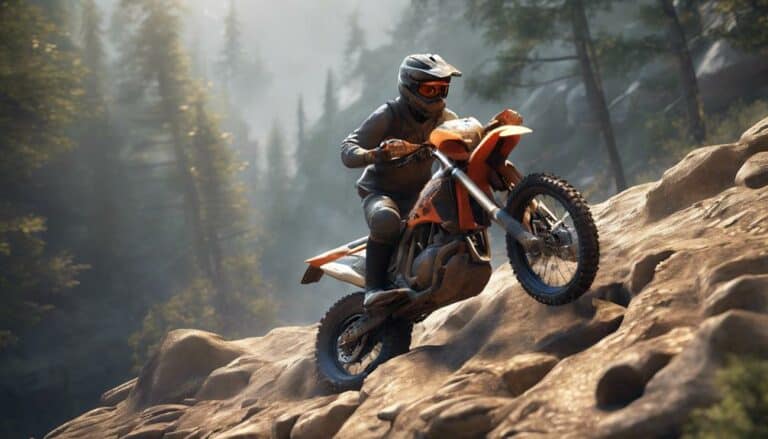When tackling obstacles and rough terrain while trail riding, mastering advanced techniques like the 'wheelie' can greatly enhance your ability to navigate challenging landscapes.
By honing techniques that involve precise weight distribution, strategic braking strategies, and expert body positioning, you can elevate your trail riding skills to new heights.
Stay tuned to discover how these advanced methods can help you conquer any terrain with confidence and finesse.
Key Takeaways
- Master body positioning to handle obstacles effectively.
- Utilize weight shifting and core engagement for stability.
- Choose optimal lines for smooth navigation on rough terrain.
- Practice advanced braking techniques for control and traction.
Front Wheel Lifting Techniques
To efficiently lift the front wheel while trail riding, mastering proper body positioning over the rear hub is essential. When tackling obstacles and rough terrain, your body positioning plays an important role in lifting the front wheel effortlessly. By shifting your weight back over the rear wheel, you create a pivot point that allows you to lift the front of the bike with ease. Engage in wheelie pedal and manual techniques to hone your skills in lifting the front wheel when faced with challenging trail features.
As you ride through the rough terrain, remember to unweight the bike by slightly crouching and using your arms to help lift the front wheel off the ground. This unweighting technique not only aids in lifting the front wheel but also gives you more control over maneuvering obstacles on the trail. Practice on flat surfaces, focusing on visual markers to perfect your timing and technique for lifting the front wheel when encountering various obstacles. Mastering these front wheel lifting techniques will empower you to ride with confidence and tackle any trail challenges that come your way.
Advanced Body Positioning Tips
Maintain a low center of gravity by bending your knees and elbows while standing on the footpegs to enhance stability and control during advanced trail riding. When encountering rough terrain and obstacles, it's essential to adjust your body positioning for best bike handling.
Keep your head up and eyes focused ahead to anticipate terrain changes, allowing you to react promptly. Shift your body weight towards the rear of the bike on rough terrain to maintain traction on the rear wheel, preventing loss of control.
Utilize your legs as shock absorbers to cushion the impact of bumps, reducing strain on your upper body. Engage your core muscles to stabilize your body and bike, enhancing balance over challenging terrain.
Mastering Technical Descents
When tackling technical descents, it's important to shift your weight back and lower your center of gravity to maintain control on steep terrain. Engage in proper gear selection and utilize engine braking to manage your speed effectively. Keeping your feet on the footpegs and using precise body positioning will help you navigate rocky and uneven terrain smoothly. It's essential to maintain a steady speed while descending to avoid losing traction and control.
To build confidence and enhance your technical skills, practice on varying steep descents. This will help you become more adept at handling different types of terrain and obstacles. By mastering technical descents, you will feel more in control and capable when faced with challenging landscapes. Remember, the key is to stay focused, maintain the right body position, and adjust your speed accordingly.
| Steep Descents | Proper Gear Selection | Body Positioning |
|---|---|---|
| Maintain Control | Engine Braking | Steady Speed |
Line Selection for Rough Terrain
As you navigate rough terrain, your success largely depends on your ability to choose the best line for maintaining traction and control. Here are some tips to help you master line selection for rough terrain:
- Choose Wisely: Opt for the widest and smoothest line available to enhance traction and maintain control over challenging terrain.
- Utilize Leverage Points: Look for natural features like rocks or roots that can serve as leverage points to help you navigate obstacles effectively.
- Adapt to Terrain Conditions: Adjust your chosen line based on the specific conditions of the terrain, such as loose rocks or mud, to maximize stability and control.
- Scan Ahead: Anticipate changes in the trail by scanning ahead and selecting the most efficient path through challenging sections to maintain momentum and control.
Advanced Braking and Acceleration Methods
Enhance your trail riding skills by mastering advanced braking and acceleration techniques to conquer challenging terrain with precision and control. When faced with rough terrain and obstacles, it's important to understand and apply techniques such as brake modulation, engine braking, trail braking, and clutch control.
| Braking and Acceleration Methods | Description | Benefits |
|---|---|---|
| Brake Modulation | Adjusting brake pressure for control | Precise obstacle approaches |
| Engine Braking | Using engine resistance for traction | Maintaining control on descents |
| Trail Braking | Braking while entering corners | Maximizing cornering speed and stability |
Additionally, mastering body positioning and weight distribution enhances traction control and stability. By combining these techniques with proper obstacle approach strategies, you can navigate rough terrain with confidence. Remember, control your speed, adapt to the terrain, and stay focused on the trail ahead to guarantee a safe and exhilarating ride.
Conclusion
You've honed your skills and conquered those obstacles like a pro. Remember that time you effortlessly lifted your front wheel over that fallen tree, feeling the rush of adrenaline as you smoothly navigated the rough terrain?
Keep practicing, keep pushing yourself, and soon you'll be tackling even bigger challenges with ease. Stay focused, stay determined, and keep enjoying the thrill of mastering the trails.
Happy riding!

